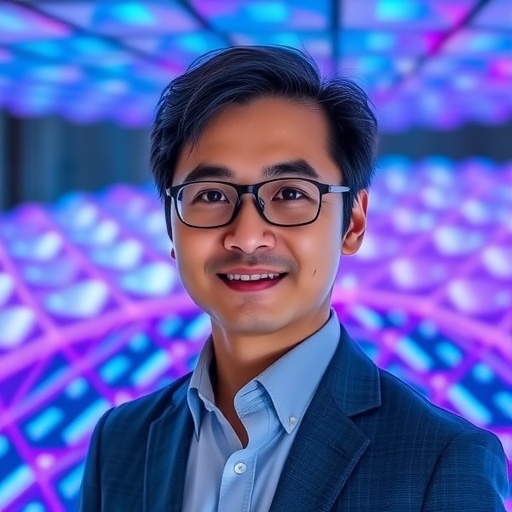In the rapidly evolving landscape of photonics and metamaterial design, a new paradigm shift is underway, promising to revolutionize how complex optical devices are conceived and realized. Professor Lei Zhou, a leading figure in the field, recently shared insights into a transformative theoretical framework that could dramatically streamline the design of inhomogeneous metasurfaces—structures that manipulate light with unprecedented precision and flexibility. His approach, rooted deeply in first-principles physics, marks a decisive departure from the conventional dependency on exhaustive simulations and empirical parameter scanning, traditionally a bottleneck in the development cycle of such photonic devices.
.adsslot_bYITKpiX8O{ width:728px !important; height:90px !important; }
@media (max-width:1199px) { .adsslot_bYITKpiX8O{ width:468px !important; height:60px !important; } }
@media (max-width:767px) { .adsslot_bYITKpiX8O{ width:320px !important; height:50px !important; } }
ADVERTISEMENT
The implications of this development extend beyond mere computational efficiency. The framework bridges the gap between abstract theoretical physics and practical engineering, facilitating designs that are not only precise but also robust against fabrication tolerances and environmental variability. Such robustness is critical for translating metasurface concepts from laboratory curiosities into real-world optical components with scalable production potential.
Furthermore, Professor Zhou emphasizes that this work coincides perfectly with the ascendancy of artificial intelligence (AI) tools, which are increasingly being integrated into scientific research workflows. While AI has already shown promise in accelerating material discovery and device optimization, its synergy with a solid, physics-based theoretical framework could catalyze a revolution in how photonic devices are designed. By constraining the design space through rigorous theory, AI algorithms can operate more efficiently, focusing computational resources on promising regions and potentially uncovering entirely new classes of metasurface functionalities.
This hybrid approach of physics-informed computational design supported by AI heralds a new era of intelligent photonics. It empowers designers to tackle complex, multi-parameter problems that were previously considered intractable or too resource-intensive. As a result, emerging technologies relying on metasurfaces—such as compact lenses, beam shapers, holographic displays, and advanced sensors—may witness accelerated development cycles and enhanced capabilities.
However, the transition to this new design methodology is not without challenges. Compared to widely adopted numerical methods like FDTD, Professor Zhou acknowledges that his theoretical framework initially appears more abstract and mathematically sophisticated, potentially posing a barrier to widespread adoption. Its complexity demands a deeper understanding of electromagnetic theory, which may seem less accessible to engineers and experimentalists accustomed to intuitive, simulation-based workflows.
Recognizing this, the research team is actively engaged in democratizing this approach by developing user-friendly tools, comprehensive tutorials, and open-source software implementations. These educational resources aim to make the sophisticated theory more approachable and integrated into standard photonics design toolkits. The vision is to cultivate a broad community of users who can leverage these advances without being hindered by conceptual or technical difficulties.
The potential for broader impact also resonates with trends in photonics towards miniaturized, multifunctional components. As devices shrink and become more intricate, traditional trial-and-error design scales poorly. Theoretical frameworks that incorporate physical insights enable designers to anticipate emergent behaviors and nonlinear effects that purely numerical methods may overlook or misinterpret. This level of predictive power is essential for engineering next-generation photonic systems that demand high efficiency, low loss, and tailored spectral responses.
Moreover, the framework’s capability to reduce design times aligns well with industrial demands, where time-to-market pressures are relentless. Faster and more precise metasurface design workflows can accelerate prototyping, reduce costs, and foster innovation cycles that keep pace with other rapidly advancing technologies. Industries ranging from telecommunications and augmented reality to medical imaging stand to benefit significantly.
In addition to industrial applications, Professor Zhou’s work opens new avenues in fundamental science. By elucidating the connections between metasurface geometry, material composition, and electromagnetic response from a foundational standpoint, researchers gain deeper insights into wave phenomena and metamaterial physics. These insights could fuel novel discoveries in related fields such as topological photonics, nonlinear optics, and quantum light-matter interactions.
The integration of this theoretical framework with experimental methodologies also represents a fertile ground for cross-disciplinary collaboration. Material scientists, optical engineers, and physicists are encouraged to converge, leveraging collective expertise to push meta-device innovation beyond incremental improvements. This collaborative spirit is crucial for translating theoretical advances into practical devices with transformative properties.
Looking forward, the growing computational power available alongside AI accelerators and quantum-inspired algorithms promises to further synergize with Professor Zhou’s framework. Such computational advancements will expand the tractable complexity of metasurface designs, enabling the exploration of higher-dimensional design spaces and multifunctional objectives. This trajectory points to a future where metasurface design becomes an almost intuitive process, informed by both deep physical understanding and intelligent computational guidance.
In conclusion, Professor Lei Zhou’s theoretical framework signifies a pivotal moment in the history of metamaterial science. By coupling first-principles physics with emerging AI technologies, it promises to lift long-standing design bottlenecks, fostering rapid, efficient, and sophisticated metasurface engineering. As the research community embraces and refines this approach, it is poised to unlock new scientific frontiers and technological breakthroughs that could reshape the optical landscape in the coming decades.
The challenges of making such a complex framework accessible should not be underestimated, but with ongoing efforts to disseminate knowledge and integrate user-friendly tools, an exciting, inclusive era of metasurface research and application is on the horizon. This progress exemplifies how foundational science, when combined with pragmatic innovation, can catalyze transformative impacts in technology and society.
Article References:
Guo, C. Light People: Prof. Lei Zhou spoke about metasurfaces.
Light Sci Appl 14, 231 (2025). https://doi.org/10.1038/s41377-025-01893-z
Image Credits: AI Generated
Tags: analytical approaches in photonicsefficient design methodologies for photonicselectromagnetic wave manipulationfirst-principles physics in opticsmetasurface design techniquesoptical device innovationovercoming computational challenges in metasurfacesphotonics and metamaterialsProfessor Lei Zhou insightsrevolutionizing optical device developmenttailored optical responses in metamaterialstransformative theoretical frameworks in optics





